|
|
|
Schwerer Panzerspähwagen Sdkfz 232 (8 Rad) - Tamiya MM136 |
|
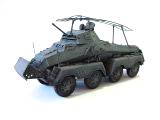 Specification : Manufacturer : Deutsche Werke, Schichau Chassis number : 59902 - 87267 607 units produced from 1936 to September 1943 Crew : 4 Weight : 8.3 tons Length : 5.85 m Width : 2.2 m Height : 2.35 m Engine : Büssing NAG L8V Gearbox : 6 forward, 6 reverse Speed : 85 km/h Range : 300 km Radio : FuG12 & FuG Spr Ger 'a' Armament : one 2cm KwK30 or 38, One 7.92mm MG34 Ammunition : 180 (2cm), 1,050 (MG34) Traverse : 360° hand Elevation : -10° +26° Sight : TZF6 |
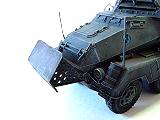 Contrary to prewar expectation, the battle between Germany and Poland
which led to the Second World War ended in only four weeks in an
overwhelming victory for the Germans through the astounding exploits of
their panzer units.
Contrary to prewar expectation, the battle between Germany and Poland
which led to the Second World War ended in only four weeks in an
overwhelming victory for the Germans through the astounding exploits of
their panzer units.
People in the world were astonished at the power of the German panzer units which brought about the signal victory. It was really astonishing to everyone that the German Army., which had been beaten in World War I and prohibited from using armored car as well as tanks, reappeared like the phoenix with the panzer units having the newest equipment. Above all, motorcycle infantry crops which rushed in the van of the panzer units and armored car corps which supported them attracted much attention by their high speed. The main body of German reconnaissance battalions to which these corps belonged consisted of unique-shaped eight wheeled heavy armored cars. Hidden behind the brilliant activity of the graceful high speed heavy armored cars were great pains of years development continued by the Germans who had been prohibited by the Treaty of Versailles even from manufacturing armored cars. Early in the 1920's, the mechanization of the German Army was still in the Melting pot. In Germany of those days, it was only the police that was allowed to used armored cars. In 1926, the German Army Ordnance Bureau secretly handed specifications consisting of 14 items to three police car manufacturers and requested them to develop chassis for typical eight and ten wheeled armored cars under the pretext that they were to be used only by the police. Pilot models based on the specifications were all completed in 1929. Daimler Benz made an eight wheeler with confidence under the leadership of Dr. F.Porsche. Magirus constructed another eight wheeler in rivalry with Daimler Benz. Büssing built a ten wheeler. The pilot models of these three manufacturers were of the four or five axle all wheel driven type and had a driver seat in front and at the rear of the body. They employed stable suspension system and durable chassis and frame which made it possible to run at a speed of 100 km/h. To elude the Armament Inspection Committee of the League of Nations, however, the Germans had to remove the rear driver seat and apply cork on the armor plate. After being put to simple tests by the manufacturers, the pilot models were brought to the Kummersdorf and Wünsdorf proving grounds of the Germany Army. Sufficient running trials of these vehicles were repeated there by German engineers. Thereafter they were delivered to the Army and further sent to the proving ground of the German Army Ordnance 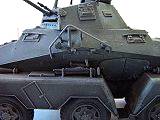 Development Bureau then located at
Kazan in the eastern part of Russia under the pretext that their parts had
to be put to endurance tests. Accurate tests of all parts and field
experiments just like actual fighting were made at the proving ground in
Russia.
Development Bureau then located at
Kazan in the eastern part of Russia under the pretext that their parts had
to be put to endurance tests. Accurate tests of all parts and field
experiments just like actual fighting were made at the proving ground in
Russia.In October 1929, the economic depression which suddenly set in the United States Attacked Germany too. Because of the drastic reduction of the budget consequent upon the severe depression in addition to the restriction imposed by the Treaty of Versailles, drafts and data of the pilot models thus tested were destined to be put away in a data room for years in vain. In 1933 when Adolf Hitler came into power and Germany left the League of Nations, German armament began to expand quickly. The plan for the eight wheeled armored car which had been stalled for years was now set on foot again. As a part of the German Army's standard fighting vehicle production plan, the German Army Ordnance Bureau decided in 1934 to develop an eight wheeled heavy armored car for reconnaissance troops and officially requested Büssing to design its chassis. Although Büssing gave up its own plan for the ten wheeler because the production cost was too high. it developed a new chassis for the eight wheeler on the basis of experience it had accumulated with great pains since the 1920s and with reference to valuable data furnished by Daimler Benz and Magirus. Thus was completed a good chassis call Type GS for the eight wheeled armored car. a The GS chassis consisted mainly of simple and tough straight members and employed eight wheel independent suspension system. Wheels on each side were connected two by two in a row with a long leaf spring. All wheel driven system was employed. A transmission with three forward and three reverse speeds was mounted near the center of the chassis and could be controlled from either the front or the rear driver's seat. A Büssing L8V petrol engine offering 150 bhp, later 180 hp was mounted at the rear of the chassis. The maximum speed was 100 km/h. The development of the body covered with armor plates was put in charge of the Kiel factory of Deutsche Werke which had experience in six wheeled armored cars, for better protection against bullets, the body had a linear and graceful shape characteristic of German Military vehicles. The body style was stressed by large fenders over wheels connected two by two. Armor thickness was 14.5mm in the front part, 30mm in only the last production type, 8mm on both sides and 5mm at the top. This means that the armor was light and designed to resist rifle bullets at the best. 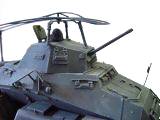 A 20mm machine gun KwK 30, later KwK38, and a machine gun MG34 were
coaxially mounted on the revolving turret. The eight wheeled heavy armor
car was put to production in 1937. This vehicle was classified into the
following four types according to equipment and armament :
A 20mm machine gun KwK 30, later KwK38, and a machine gun MG34 were
coaxially mounted on the revolving turret. The eight wheeled heavy armor
car was put to production in 1937. This vehicle was classified into the
following four types according to equipment and armament :1) Heavy armored car Sdkfz 231 - 8 rad 2) Heavy armored car Sdkfz 232 - 8 rad with radio apparatus. 3) Heavy armored car Sdkfz 233 - 8 rad with 75mm gun. 4) Armored Radio Car Sdkfz 263 - 8 rad. The eight wheeled armored car Sdkfz 232 was equipped with a radio apparatus Fu-11, later Fu-12, on the division level and carried a large frame antenna (Bügel Antenne) over the body. The Fu-11 was a very good unit consisting of 100 watt medium wave transmitter, receiver, power source and other accessories. It had a coverage of 50km in radius. The Sdkfz 232 was also equipped with a radio telephone on the company level which was usually seen in tanks. In 1938, eight wheeled heavy armored car began to be delivered to the reconnaissance battalion of tank divisions, light divisions and infantry divisions in place of six wheeled armored cars. The eight wheelers were to show activity as the eye of the division and the eye of the commander. The eight wheeled heavy armored car Sdkfz 232 with a frame antenna carried a crew of four men. The commander and the gunner were in the turret, and other two men sat in the front and the rear driver seat. Because the turret carrying the 20mm machine gun was too small for two men and, to make matters worse, the radio apparatus Fu-11 took up much space, they had great operational difficulty. Therefore the production of the Sdkfz232 was discontinued in May 1940. The duty of radio communication was gradually entrusted to the turret less armored radio car Sdkfz 263. In actual fighting, the eight wheeled heavy armored car excelled others in speed and cross country ability, but their silhouette was too high and armor was too thin. To reinforce their armor, the Germans hastely added an armor plate of 10mm thickness to the front of the body but the result was not quite satisfactory. The eight wheeled heavy armored car of the four types entered production in 1937. A total of 1,235 were produced in about five years from 1937 to January 1942 when the last armored radio car left the factory. After that, the position of being the main body of German reconnaissance battalions was accepted by the new eight wheeled heavy armored car Sdkfz 234 equipped with heavier armor and more powerful armament. (From Tamiya Manual - Akira Kikuchi)) |
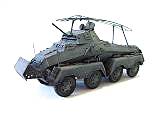 |
|
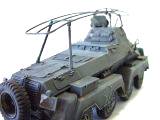 |
|
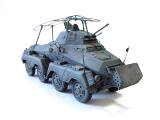 |
|
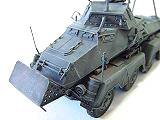 |
|
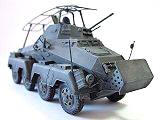 |
|
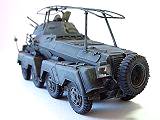 |
|
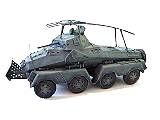 |
|
 |
|
©
one35th - Last updated on :
Sunday, April 05, 2009 |
|